|
Agriculture in the Philippines
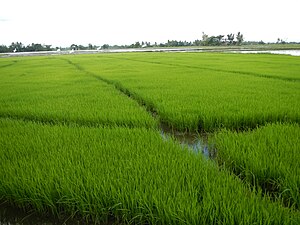 Agriculture in the Philippines is a major sector of the economy, ranking third among the sectors in 2022 behind only Services and Industry. Its outputs include staples like rice and corn, but also export crops such as coffee, cavendish banana, pineapple and pineapple products, coconut, sugar, and mango.[1] The sector continues to face challenges, however, due to the pressures of a growing population. As of 2022[update], the sector employs 24% of the Filipino workforce[2] and it accounted for 8.9% of the total GDP.[3]  The Philippines is one of the most vulnerable agricultural systems to monsoons and other extreme weather events,[4] which are expected to create more uncertainty as climate change affects the Philippines. However, the Food and Agriculture Organization has described the local policy measures as some of the most proactive in risk reduction.[5] History
The means by which agriculture expanded into the Philippines is argued by many different anthropologists and an exact date of its origin is unknown.[6][7][8][9] However, there are proxy indicators and other pieces of evidence that allow anthropologists to get an idea of when different crops reached the Philippines and how they may have gotten there.[10][11] Rice is an important agricultural crop today in the Philippines and many countries throughout the world import rice and other products from the Philippines.[12] Present dayIn 2022, the country's chief economist Arsenio Balisacan said that Philippine agriculture was in crisis, citing such issues as the high price of meat and rice and low profitability for farmers.[13] FarmersThere are 10.66 million people employed in agriculture in the Philippines.[14] The average daily wage for farmers is PHP331.10. Men on average earn PHP335.00 a day, while women earn an average PHP304.60 a day.[15] Many of the Philippines' farmers operate small-sized farms which have been granted to them as a result of several decades of land reform programs. While land reform is enshrined in the Philippines' 1987 Constitution as a means of ensuring the welfare of small farmers, the land distribution component of these land reform programs have largely not yet been followed through with the agricultural services and infrastructure development needed to make these smallholder farms economically efficient or productive.[16] Economists such as Bernardo M. Villegas have cited the potential of interventions such as Farmers' Cooperatives which would allow smallholder farms to achieve the economies of scale needed to become more economically viable.[16] Many Filipino farmers live in poverty due to a combination of factors, including economic policy, environmental, and land ownership issues.[17][18] ProfessionIn the Philippines, the official professional designation is Licensed and Registered Agriculturist[19] but is more commonly shortened as "Licensed Agriculturist" or more simply as "Agriculturist". They are licensed and accredited after successfully passing the Agriculturist Licensure Examination, regulated by the Professional Regulation Commission and the Board of Agriculture.[20] A Licensed Agriculturist can affix the title "L.Agr." (as name suffix) or "Agr." (as name prefix) to indicate the profession.[21] The primary role of agriculturists are to prepare technical plans, specifications, and estimates of agriculture projects such as in the construction and management of farms and agribusiness enterprises.[22] The practice of agriculture also includes the following:
A prospective professional agriculturist is typically required to have a four-year Bachelor of Science degree in Agriculture, although other degree programs directly related to agriculture are also allowed to take the licensure examination if they earn at least eighteen (18) units of agriculture credits from a recognized higher education institution.[23] About 5,500 registered agriculturists pass the licensure examination annually.[24] It is one of the hardest licensure examinations in the country with 29.84% passing rate in November 2021.[25][26] The agriculturist profession and its board of agriculturists were created in 2002 by the Professional Regulation Commission,[23] in order to "upgrade the agriculture and fisheries profession"[27] by the virtue of the Agriculture and Fisheries Modernization Act of 1997. The practice of the agriculture profession is a professional service admission. Similar to other professions in the Philippines, malpractice and illegal practice of agriculture are grounds for suspension or revocation of certificates of registration and professional licenses.[28] Licensed agriculturists in the Philippines are integrated into one accredited integrated professional organization, which is the Philippine Association of Agriculturists.GrainsRice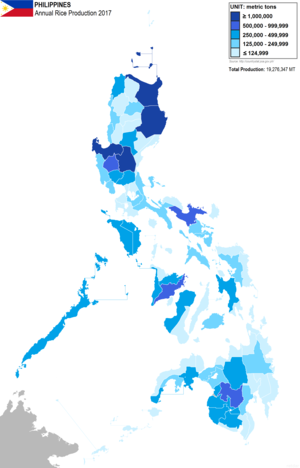 The Philippines is the 8th largest rice producer in the world, accounting for 2.8% of global rice production.[29] The Philippines was also the world's largest rice importer in 2010.[30] In 2010, nearly 15.7 million metric tons of palay (pre-husked rice) were produced.[31] In 2010, palay accounted for 21.86% percent of gross value added in agriculture and 2.37% of GNP.[32] Self-sufficiency in rice reached 88.93% in 2015.[33] Rice production in the Philippines has grown significantly since the 1950s. Improved varieties of rice developed during the Green Revolution, including at the International Rice Research Institute based in the Philippines, have improved crop yields. Crop yields have also improved due to increased use of fertilizers. Average productivity increased from 1.23 metric tons per hectare in 1961 to 3.59 metric tons per hectare in 2009.[29][original research?] Harvest yields have increased significantly by using foliar fertilizer (Rc 62 -> 27% increase, Rc 80 -> 40% increase, Rc 64 -> 86% increase) based on PhilRice National Averages.[34] The government has been promoting the production of golden rice.[35] However, in April 2023, the Supreme Court of the Philippines issued a Writ of Kalikasan ordering the Department of Agriculture to stop the commercial distribution of genetically modified rice and eggplants in the country.[36] The table below shows some of the agricultural products of the country per region.[37]
Corn/maize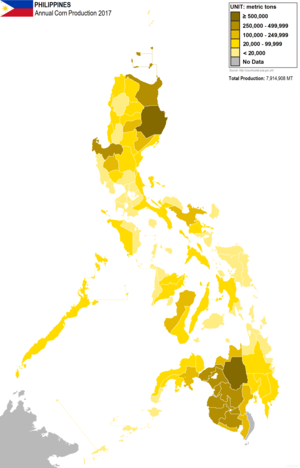 Corn/maize is the second most important crop in the Philippines. 600,000 farm households are employed in different businesses in the corn value chain. As of 2012[update], around 2.594 million hectares (6.41×106 acres) of land is under corn cultivation and the total production was 7.408 million metric tons (8.166×106 short tons).[38] The government has been promoting Bt corn for hardiness against insects and higher yields.[35] Other food cropsChocolate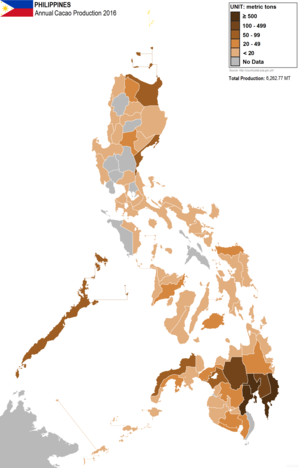
The chocolate industry in the Philippines developed after the introduction of the cocoa tree to Philippine agriculture. The growing of cacao or cocoa boasts a long history stretching from the colonial times. Originating from Mesoamerican forests, cacao was first introduced by the Spanish colonizers four centuries ago.[39] Since then the Philippine cocoa industry has been the primary producer of cocoa beans in Southeast Asia. There are many areas of production of cacao in the Philippines, owing to soil and climate. The chocolate industry is currently on a small to medium scale. Coffee Coffee is an important agricultural product in the Philippines, and is one of the Philippines' most important export products[40] aside from being in high demand in the country's local consumer market.[41] The Philippines is one of the few countries that produce the four main viable coffee varieties; Arabica, Liberica (Barako), Excelsa and Robusta.[42] 90 percent of coffee produced in the country is Robusta. There have been efforts to revitalize the coffee industry.[43] As of 2014, the Philippines produces 25,000 metric tons of coffee and is ranked 110th in terms of output. However local demand for coffee is high with 100,000 metric tons of coffee consumed in the country per year.[41] Coffee was said to have been introduced in the Philippines around 1696 when the Dutch introduced coffee in the islands. It was once a major industry in the Philippines, which by the 1800s was the fourth largest coffee producing nation.[44] However, Islamic culture has been pervaded by coffee drinkers from the 1500s. And with the close ties of the Philippines to the Islamic World since the 12th century, it would not be impossible to speculate that coffee has been in the Philippines before the Dutch "introduced" it.[45]CoconutsCoconuts play an important role in the national economy of the Philippines. According to figures published in December 2015 by the Food and Agriculture Organization of the United Nations, it is the world's largest producer of coconuts, producing 19,500,000 tonnes in 2015.[46] Production in the Philippines is generally concentrated in medium-sized farms.[47] There are 3.5 million hectares dedicated to coconut production in the Philippines, which accounts for 25 percent of total agricultural land in the country.[48] In 1989, it was estimated that between 25 percent and 33 percent of the population was at least partly dependent on coconuts for their livelihood. Historically, the Southern Tagalog and Bicol regions of Luzon and the Eastern Visayas were the centers of coconut production.[49] In the 1980s, Western Mindanao and Southern Mindanao also became important coconut-growing regions.[49] Fruits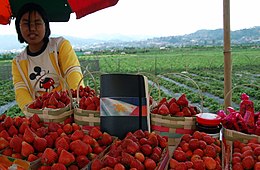 The Philippines is the world's third largest producer of pineapples, producing more than 2.4 million of tonnes in 2015.[50] The Philippines was in the top three banana producing countries in 2010, including India and China.[51] Davao and Mindanao contribute heavily to the total national banana crop.[51] Mangoes are the third most important fruit crop of the country based on export volume and value next to bananas and pineapples.[52] Sugar There are at least 19 provinces and 11 regions that produce sugarcane in the Philippines. A range from 360,000 to 390,000 hectares are devoted to sugarcane production. The largest sugarcane areas are found in the Negros Island Region, which accounts for 51% of sugarcane areas planted. This is followed by Mindanao which accounts for 20%; Luzon by 17%; Panay by 07%; and Eastern Visayas by 04%.[53] It is estimated that as of 2012[update], the industry provides direct employment to 700,000 sugarcane workers spread across 19 sugar producing provinces.[54] Sugar growing in the Philippines pre-dates colonial Spanish contact.[55] Sugar became the most important agricultural export of the Philippines between the late eighteenth century and the mid-1970s.[55] During the 1950s and 60s, more than 20 percent income of Philippine exports came from the sugar industry.[55] Between 1913 and 1974, the Philippines sugar industry enjoyed favoured terms of trade with the US, with special access to the protected and subsidized the American sugar market.[55] Negros famine
The Negros famine took place on Negros island in the Philippines in the mid-1980s, during the waning days of the Marcos dictatorship.[56][57] It was a key moment in the history of sugar production in the Philippines, as well as the broader political history of the Philippines. Caused by the Marcos administration's efforts to control sugar production through the NASUTRA monopoly held by Marcos crony Roberto Benedicto and by a sudden crash in international sugar prices, it created what popularly came to be known as a "social volcano", with tensions culminating in the Escalante massacre, and with negative effects still felt even after the ouster of Ferdinand Marcos and his cronies during the 1986 People Power Revolution.[58][59] Animal agriculture AquacultureAquaculture in the Philippines (which includes fish, shellfish, and seaweed farming) comprises 39% of the country's fisheries sector. The rest of the fisheries sector is composed of commercial and municipal fishing.[60] Some of the more common aquaculture products in the Philippines are bangus, tilapia, catfish and mudfish, and prawns.[60] Up to 27% of total aquaculture production comes from the Bangsamoro Autonomous Region in Mindanao.[60] Aquaculture accounts for 51% of fish produced in the country.[61] Climate change poses a major threat to fishing and fish farming in the Philippines.[62] Crocodile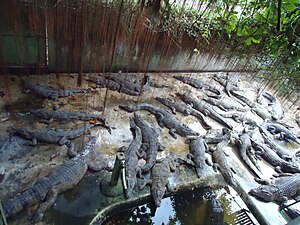 Crocodile farming in the Philippines refers to agricultural industries involving the raising and harvesting of crocodiles for the commercial production of Crocodile meat and crocodile leather. In the Philippines, crocodile farmers breed and raise two species of Philippine crocodiles: the Philippine saltwater crocodile (Crocodylus porosus)[63] and the Philippine freshwater crocodile (Crocodylus mindorensis). Farms that trade crocodile skin are regulated by the Convention on International Trade in Endangered Species (CITES).[63][64] Crocodiles help maintain the balance of Philippine ecosystems such as wetlands; crocodile farming in the Philippines is also geared towards the rescue and conservation of both C. porosus and the "endangered and endemic" C. mindorensis. Crocodile farms also contribute to tourism in the Philippines and offer public education about crocodiles.[63][64]Ostrich
The business of ostrich farming in the Philippines began in the Philippines in 1996. It was started by Lorenzo U. Limketkai, an engineer, and his son Heintje Limketkai. Heintje Limketkai took a month-long training course on ostrich farming in Australia. After that training, the Limketkais established their ostrich farming business and named it as the Philippine Ostrich and Crocodile Farms, Inc.,[65] becoming the first combined ostrich and crocodile farm in the country.[66] Other cropsAbaca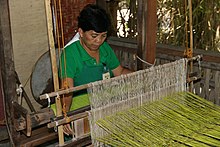 According to the Philippine Fiber Industry Development Authority, the Philippines provided 87.4% of the world's abaca in 2014, earning the Philippines US$111.33 million.[67] The demand is still greater than the supply.[67] The remainder came from Ecuador (12.5%) and Costa Rica (0.1%).[67] The Bicol region in the Philippines produced 27,885 metric tons of abaca in 2014, the largest of any Philippine region.[67] The Philippine Rural Development Program (PRDP) and the Department of Agriculture reported that in 2009–2013, Bicol Region had 39% share of Philippine abaca production while overwhelming 92% comes from Catanduanes Island. Eastern Visayas, the second largest producer had 24% and the Davao Region, the third largest producer had 11% of the total production. Around 42 percent of the total abaca fiber shipments from the Philippines went to the United Kingdom in 2014, making it the top importer.[67] Germany imported 37.1 percent of abaca pulp from the Philippines, importing around 7,755 metric tons (MT).[67] Sales of abaca cordage surged 20 percent in 2014 to a total of 5,093 MT from 4,240 MT, with the United States holding around 68 percent of the market.[67] Rubber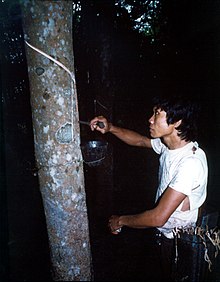 There are an estimated 458,000 families dependent upon the cultivation of rubber trees. Rubber is mainly planted in Mindanao, with some plantings in Luzon and the Visayas.[68] As of 2013[update], the total rubber production is 111,204 tons.[69] GovernmentThe Food and Agriculture Organization described local policy measures as some of the most proactive in risk reduction.[5] The government supports the approval and cultivation of genetically modified crops.[35] However, the Supreme Court issued injunctions against genetically modified products in 2015 and 2023. Farmers and environmentalists have held demonstrations and filed court petitions protesting the promotion, cultivation, and sale of genetically modified products in the Philippines.[70][71] Department of Agriculture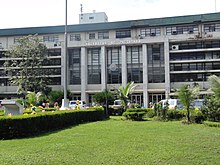 The Department of Agriculture (abbreviated as DA; Filipino: Kagawaran ng Pagsasaka) is the executive department of the Philippine government responsible for the promotion of agricultural and fisheries development and growth.[72] It has its headquarters at Elliptical Road corner Visayas Avenue, Diliman, Quezon City. The department is currently led by the secretary of agriculture, nominated by the president of the Philippines and confirmed by the Commission on Appointments. The secretary is a member of the Cabinet. The current secretary is Francisco Tiu Laurel Jr., who assumed office on November 3, 2023.Land reform
Land reform in the Philippines has long been a contentious issue rooted in the Spanish colonial period. Some efforts began during the American colonial period with renewed efforts during the Commonwealth, following independence, during martial law, and especially following the People Power Revolution in 1986. The current law, the Comprehensive Agrarian Reform Program, was passed following the revolution and extended until 2014. Environmental and social issuesDeforestationSome agricultural practices, including export crops and encroachment by small farmers, lead to deforestation.[73] Deforestation may in turn affect water supply needed by farms.[73] Water supply and soil qualityDue to the loss of watershed areas, water supply and quality have decreased. Deforestation has also resulted in erosion and siltation, leading to worsened water quality.[73] Heavy use of chemical fertilizers have also led to declining soil quality.[73] Climate changeAgriculture is one of the Philippines' largest sectors and will continue to be adversely impacted by the effects of climate change. The agriculture sector employs 35% of the working population and generated 13% of the country's GDP in 2009.[74] The two most important crops, rice and corn, account for 67% of the land under cultivation and stand to see reduced yields from heat and water stress.[74] In addition to these challenges, the agricultural sector in the Philippines has also been significantly impacted by the drought conditions induced by El Niño. This phenomenon has led to considerable agricultural losses, estimated at about 4.4 billion pesos ($76.2 million). Nearly 78,000 hectares of agricultural land, predominantly used for rice cultivation, have been affected.[75] Rice, wheat, and corn crops are expected to see a 10% decrease in yield for every 1 °C increase over a 30 °C average annual temperature.[76] Increases in extreme weather events will have devastating effects on agriculture. Typhoons (high winds) and heavy rainfall contribute to the destruction of crops, reduced soil fertility, altered agricultural productivity through severe flooding, increased runoff, and soil erosion.[76] Droughts and reduced rainfall lead to increased pest infestations that damage crops as well as an increased need for irrigation.[76] Rising sea levels increases salinity which leads to a loss of arable land and irrigation water.[76] All of these factors contribute to higher prices of food and an increased demand for imports, which hurt the general economy as well as individual livelihoods.[76] From 2006 to 2013, the Philippines experienced a total of 75 disasters that cost the agricultural sector $3.8 billion in loss and damages.[76] Typhoon Haiyan alone cost the Philippines' agricultural sector an estimated US$724 million after causing 1.1 million tonnes of crop loss and destroying 600,000 ha of farmland.[77] The agricultural sector is expected to see an estimated annual GDP loss of 2.2% by 2100 due to climate impacts on agriculture.[76]Land conversionAgricultural areas are being subjected to land conversion to make way for development projects, to the detriment of farmers' welfare and the country's food security.[78] According to former Department of Agriculture secretary Florencio Abad, farmlands are also being converted for non-agricultural purposes, such as for housing subdivisions, shopping centers, golf courses or recreation camps, export processing zones, and mining exploration.[79] Massive land use conversion occurring in the country harms the agricultural sector in general and has negative effects on food security and rice supply. It also leads to higher prices for basic commodities and worsens the country's dependence on agricultural imports.[79] Poverty among farmersFarmers and fishers belong to the poorest sectors of Philippine society. The incidence of poverty among farmers was estimated at 31.6% in 2018[80] (compared to the 16.7% national poverty incidence),[81] according to data from the Philippine Statistics Authority. Low-skilled agricultural workers usually receive wages at rates following the regional daily minimum wage set by the government. These rates are close to the national poverty threshold.[82] The issue of low wages may be compounded by landlessness among farmers, as well as contractual and informal work arrangements that do not provide job security or continuing access to statutory benefits (such as health benefits and other social safety nets).[82] Contractual and informal work arrangements also create barriers that prevent farmers from exercising their constitutional right to free association and collective bargaining, which in turn prevent workers from gaining higher pay and developing new skills.[82] Occupational hazardsFarmers in the Philippines are exposed to various occupational safety and health hazards. These include exposure to harmful pesticides and chemical fertilizers, physical injuries, and long work hours, according to the International Labour Organization.[83] Human rightsFarmers, fishers, land reform advocates, labor rights activists, and ancestral land defenders have been harassed or killed in the Philippines by state and non-state actors. During the 2021 commemoration of the Mendiola massacre, the Commission on Human Rights called for "an end to all killings and impunity in the country" and stressed "the need to protect the people's right to protest and express dissent, as well as to resist any move that would diminish or undermine the people's enjoyment of their rights".[84] House Bill 1112 filed in Congress seeks to declare January 22 as National Farmer's Day.[85] See alsoReferences
Further reading
External links
|